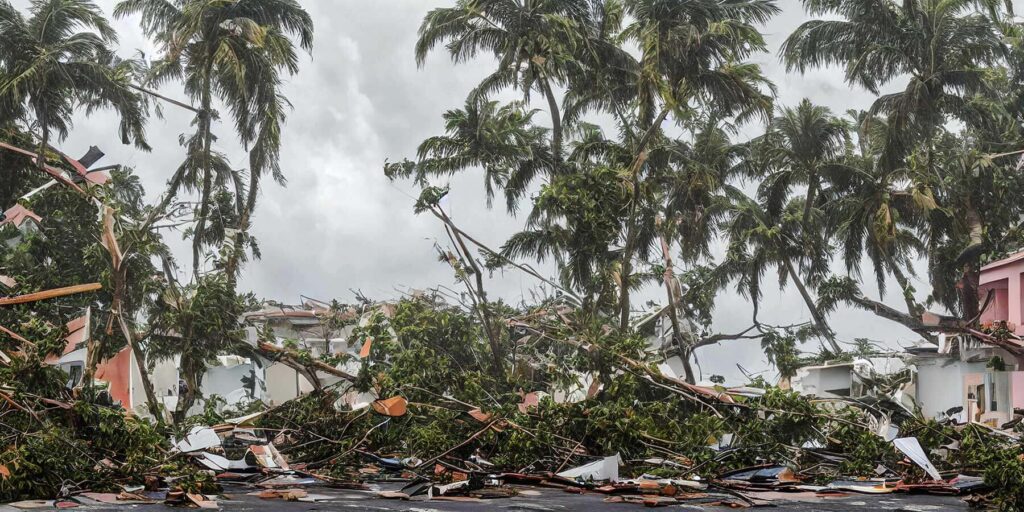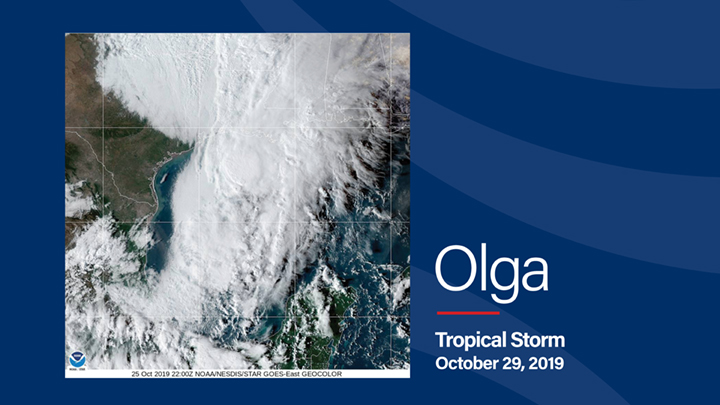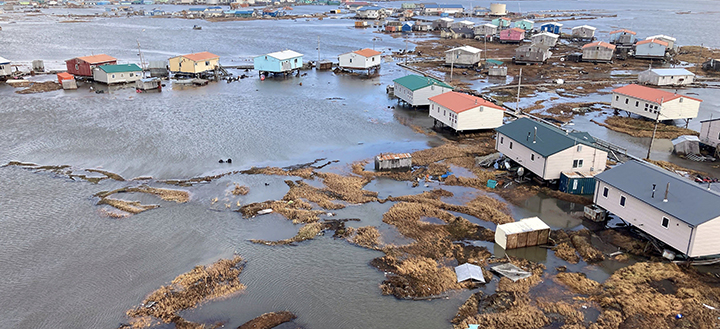Tropical storms and hurricanes remind us of the incredible power of nature and the importance of staying prepared. One of these potential systems, this year is Olga. Olga has a history with Hurricane Olga in 2001, as well as Tropical Storm Olga in 2007 and 2019.
This article will explore Olga’s history, development, and impact. We’ll also cover how tropical cyclones are named, the advancements in forecast tracking, and why these storms should never be underestimated.
Olga on the 2025 List of Named Storms
The name Olga is the 15th name on the list for the 2025 Atlantic hurricane season. The name will only be used if the season produces enough named systems to reach it alphabetically.
The fact that the name Olga remains on the storm list shows that, while previous storms with that name caused some impact, they weren’t destructive enough to be retired. Name retirement is typically reserved for especially catastrophic storms, like Katrina in 2005 or Maria in 2017.
Past Storms Named Olga
Hurricane Olga (2001)
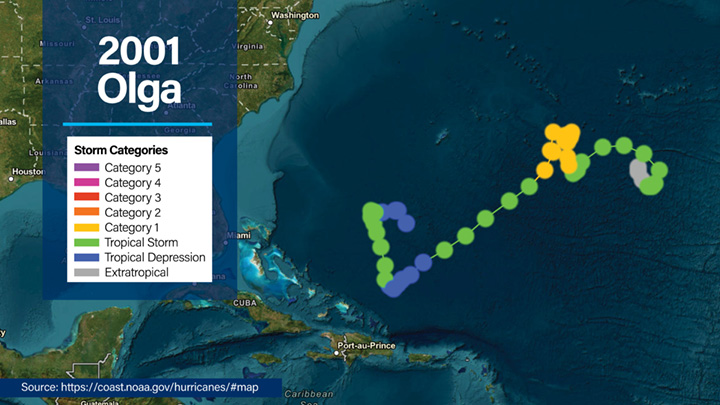
Hurricane Olga formed late in the 2001 season and reached Category 1 status. It materialized in December, which showed that while the Atlantic hurricane season officially ends on November 30, storms can still form late in the year. Although Olga primarily remained over open waters and avoided causing widespread destruction, its extended lifespan made it a noteworthy event.
Tropical Storm Olga (2007)
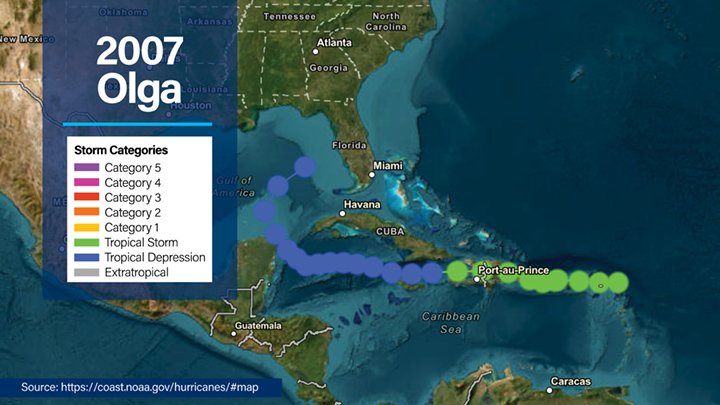
2007 Tropical Storm Olga was a rare, short-lived tropical system that formed out of season in the Atlantic.
It originated from a low-pressure system over the central Atlantic. On December 11, 2007, the system became a subtropical storm about 50 nautical miles east of San Juan, Puerto Rico. Later that day, it became a tropical storm and made landfall near Punta Cana in the Dominican Republic with maximum sustained winds of 60 mph (50 knots).
Olga brought heavy rain and flooding to parts of the Dominican Republic, Haiti, and Puerto Rico. Its remnants moved across the northwestern Caribbean Sea and into the eastern Gulf before merging with a cold front over central Florida.
Tropical Storm Olga (2019)
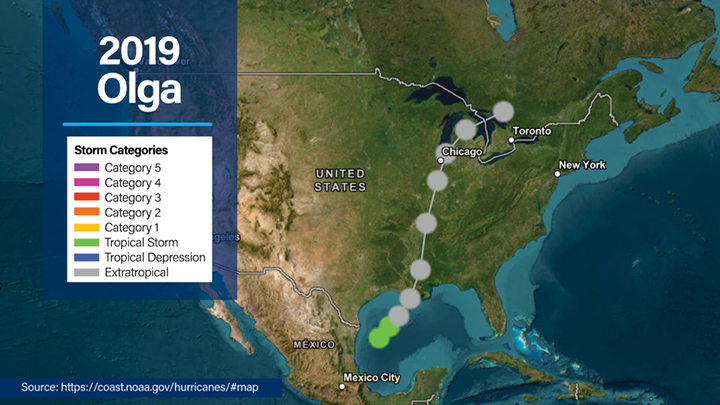
Tropical Storm Olga formed in October 2019 within the Gulf. Despite being short-lived as a tropical system, it transitioned into a post-tropical cyclone, bringing significant rainfall and localized flooding to Louisiana, Mississippi, and surrounding areas.
Olga’s heavy rains and wind gusts reinforced the reality that even storms categorized as “weaker” can still carry significant risks.
Global Impacts of Olga
The name Olga isn’t unique to the Atlantic hurricane season. It has been assigned to tropical cyclones in several global basins, including the Western Pacific and the Australian region.
In the Western Pacific, multiple cyclones named Olga have been recorded since the 1950s. These storms often differ in behavior from Atlantic systems due to regional variations in sea surface temperatures, atmospheric patterns, and landmass proximity.
In the Australian basin, the name has also appeared, with distinct impacts shaped by the geography and climate of that region.
How Storms Like Olga Get Their Names
The World Meteorological Organization (WMO) assigns tropical cyclone names to improve communication and public awareness. These names prevent confusion that might arise from using numerical or technical designations.
Each name list rotates every six years, and names are retired if storms bearing them result in widespread destruction and loss. This is so that the names of particularly destructive storms are not reused in the future, helping to maintain clarity and avoid emotional associations with past disasters.
Since no past storms named Olga were particularly severe, the name remains on the WMO’s rotational list.
Tracking the Development of Tropical Storm Olga and Hurricane Olga
The ability to monitor and predict tropical storms has significantly improved since Hurricane Olga in 2001. In the past, meteorologists relied on limited satellite imagery and data from hurricane hunter aircraft to enhance storm forecasts. By 2019, advances in high-resolution satellite technology and sophisticated forecasts, like spaghetti models and cone predictions, greatly improved tracking accuracy.
For example, during Tropical Storm Olga’s development, these tools allowed forecasters to provide timely warnings about potential flooding along Gulf Coast states.
Spaghetti models now help visualize potential storm paths derived from multiple forecast models, while cone forecasts highlight the areas most likely to experience impacts. These advancements have not only improved operational readiness but also saved lives.
Lessons from Olga Storms
- Preparedness Saves Lives and Property
Communities with comprehensive preparedness plans in place were far better equipped to handle Tropical Storm Olga in 2019 than during earlier storms. The combination of accurate forecasting and timely evacuations mitigated risks for many Gulf Coast residents. - Tropical Storms Carry Real Threats
Although classified as a “milder” system, the 2019 Tropical Storm Olga brought destructive flooding to several communities, proving that even non-hurricane events demand attention. - Technology Can Mitigate Impact
The evolution of AI, satellite imaging, and predictive modeling has transformed storm tracking capabilities. Tools like cone projections and real-time updates pave the way for better decision-making in vulnerable areas.
Frequently Asked Questions About Olga
How long did Tropical Storm Olga last?
Tropical Storm Olga in 2019 was short-lived as a tropical system, transitioning into a post-tropical cyclone within 24 hours.
What’s the difference between a tropical storm and a hurricane?
A tropical storm has sustained winds of 39 to 73 mph, while a hurricane begins at sustained winds greater than 74 mph.
Could another storm be named Olga in the future?
Yes, the name Olga is still part of the WMO’s active naming rotation and is the 15th name on the 2025 Atlantic hurricane season list.
Did the 2019 Tropical Storm Olga make landfall?
Tropical Storm Olga 2019 did not make official landfall as a tropical system, however it did bring significant rainfall to Gulf Coast states like Louisiana and Mississippi.
Staying Prepared for Hurricane Season
While we often focus on hurricanes due to their potential for catastrophic destruction, tropical storms like Olga demonstrate that water-related impacts like flooding can be just as damaging. Whether or not Olga appears in the 2025 hurricane season, we should make sure that our communities are prepared for any severe weather event.
If your agency or community needs expert guidance on storm preparedness, response planning, or recovery strategies, reach out to our team today. Together, we can work towards a safer and more resilient future.
